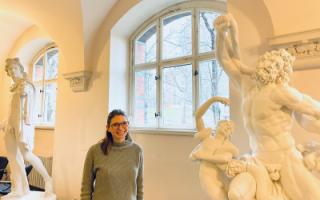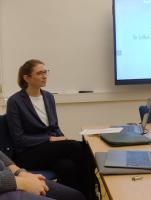From January to March 2025, I held a Wiedemann-Fellowship for Enlightenment Research at the Interdisciplinary Centre for Enlightenment Studies (IZEA) in Halle (Saale) in Germany. Over the course of three months, I had the opportunity to pursue a set of complementary aims: to consolidate my background knowledge of eighteenth-century sculpture in its broader European context, to conduct archival work relating to Jean-Antoine Houdon’s correspondence with the Duke of Saxe-Gotha, and to engage in dialogue at a research centre that, much like my own work, seeks to bridge disciplinary boundaries in the study of the Enlightenment.

My DPhil focuses on the role of sculpture in eighteenth-century France, and in particular on how different perspectives (ranging from those of artists such as Étienne-Maurice Falconet to those of philosophers and writers like Diderot and Mercier) responded to and helped shape aesthetic, philosophical, and political debates of their time. At the IZEA, I found an ideal environment to develop this work further. The centre’s director, Prof. Dr Elisabeth Décultot, is a leading expert on Johann Joachim Winckelmann, whose work is central to understanding the broader intellectual context of my research. During my stay, I was able to deepen my knowledge of Winckelmann’s reception in France, which proved especially helpful for tracing German contributions to Enlightenment ideas of form, beauty, and representation.
The fellowship also allowed me to carry out archival research at Schloss Friedenstein in Gotha. There, I consulted material relating to the correspondence between Duke Ernst II of Saxe-Gotha-Altenburg and the sculptor Jean-Antoine Houdon. I had hoped to find new or unpublished material, but most of the documents turned out to be already available in printed editions. Still, the visit was worthwhile: it helped me understand the archival context more clearly and gave me a better sense of how Houdon’s connections to German patrons fit into the wider networks I am studying.
I also found the IZEA’s wide-ranging events and its interdisciplinary environment to be an important part of the experience. I took part in a range of academic activities, including the lecture series ‘Un-Macht/Selbstermächtigung’, which examined the self-articulations of enslaved people and their afterlives; the interdisciplinary workshop ‘Lesen, Leben, Lehren’, which addressed practices of knowledge transmission and appropriation from the Enlightenment to the present day; and the conference ‘Briefe im Labor’, hosted by the DFG (German research board) project ‘Der deutsche Brief im 18. Jahrhundert’, which explored experimental approaches to epistolary studies. I was invited to write a short article on the conference, which has since been published on H-SOZ-KULT. A particular highlight for me was the inaugural workshop ‘Laokoon in Halle (Saale) und in Mexiko-Stadt’ which brought together scholars from different disciplines to discuss the histories and functions of plaster casts of the Laocoon and Apollo sculptures held in both cities. The conversation touched on questions of provenance, presentation, and the cultural work of classical forms in different institutional and geopolitical contexts. For my own research on the reception of ancient sculpture in the eighteenth century, it was both stimulating and instructive to consider how these iconic figures continue to generate debate across time and place. Finally, I also gave a presentation on my research, which allowed me to introduce aspects of my project and to connect with others working on related themes.
In addition to the IZEA’s own offerings, I also attended public lectures at the nearby Francke Foundations, including one on the digitisation of archival holdings and the role of web-based research infrastructures in preserving and accessing historical sources. While not limited to the eighteenth century, the session gave me a better understanding of current archival workflows and raised methodological questions that were relevant to my own work with historical correspondence and scattered source material.

Alongside the many academic events, one especially enjoyable occasion was attending a reading by Norwegian author Tore Renberg at the Leipzig Book Fair, together with colleagues from the IZEA. Renberg had previously spent time at the centre conducting research for his novel Die Lungenschwimmprobe, and it was interesting to hear how his stay in Halle had shaped parts of the book. The event offered a welcome change of pace and a reminder of the diverse ways in which academic environments can inspire creative work. Beyond this, Halle’s cultural landscape such as its ties to Christian Wolff and Thomasius, its Handel House, the local art school, and the beautiful Marienbibliothek offered exactly the kind of setting my work needed. The IZEA’s own library, with its calm atmosphere and superb resources, proved to be one of the most pleasant and productive workspaces I have encountered (on a par, in many ways, with those in Oxford).
It is hard to believe how quickly the three months in Halle went by. I arrived in the middle of winter and left just as spring was settling in but somehow it still felt too soon. What stayed with me most was not only the research I was able to do, but the atmosphere at the IZEA, shaped by quiet focus, friendly exchange, and a sense of shared curiosity. I remain very grateful to everyone there for making me feel so welcome and for creating a space where ideas could flourish.